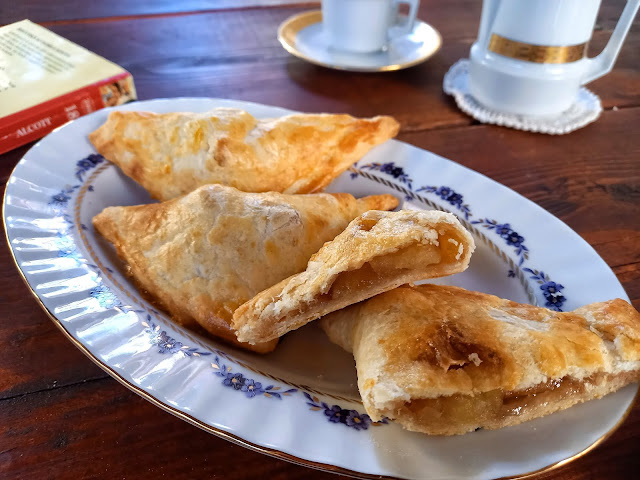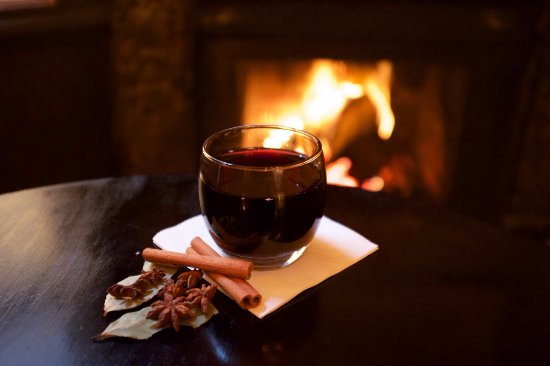‘There was a momentary lull, broken by Hannah, who stalked in, laid two hot turnovers on the table, and stalked out again. These turnovers were an institution, and the girls called them ‘muffs’, for they had no others and found the hot pies very comforting to their hands on cold mornings.
Hannah never forgot to make them, no matter how busy or grumpy she might be, for the walk was long and bleak. The poor things got no other lunch and were seldom home before two.’
Oh, how conforting would be to hold one of Hannah Mullet's warm apple turnovers, and enjoy the smell of cinnamon and butter, on these cold winter mornings of this crazy pandemic times!
Hannah is the March's family housekeeper, but she is more like a family member. She has helped raising all four sisters, she has been a friend through tough times, and I'm sure her cooking skills were most apreciated by Meg, Jo, Amy and Beth...
But you'll be wondering: the book only mentions "turnovers", how do you know they had an apple filling? A turnover can be any puff pastry pie, both sweet or savoury, but my guess is that they were in fact apple "pies" because of the time and the setting of the book.
First of all, it is said that the March family's house and its surroundings are based on Louise May Alcott's own home, the Orchard House, now a historic house museum, where she lived with her three sisters. Both the real and the fictional houses were surrounded by said orchard, and it is not difficult to imagine that it was made up mostly by apple trees, apple being the most popular and widely cultivated fuit at the time.
Moreover, apple turnovers were very popular during the late 1800s: in the second half of the 19th century, numerous recipes for them appeared on famous cooking books, such as Cassell’s Dictonary of Cookery published in 1874.
But how could we make a nice batch of hot apple turnovers today? And how would Hannah have made one in the late 1800s?
First of all, we need to make some good ol' puff pastry, and though today we can buy a ready-made sheet at the supermarket, Hannah would have definitely made her own fresh pastry dough.
We can find a very good recipe for puff pastry in Hannah Glasse's The art of Cookery made Plain & Easy from 1747 :
Puff-Paste
Take a quarter of a Peck of Flour, rub fine half a Pound of Butter, a little Salt, make it up into a light Paste with cold Water, just stiff enough to work it well up; then roll it out, and stick pieces of butter all over, and strew a little Flour; roll it up, and roll it out again; and so do nine or ten times, till you have rolled in a Pound and half of Butter. This Crust is mostly used for all Sorts of Pies.
To be honest, I would be perfectly satisfied with this recipe, since it doesn't differ much from the modern way of making puff pastry. Of course, today we would maybe use a planetary mixer or a food processor to speed up the process, but the ingredients are the same.
But the process of making the butter lamination of the dough is definitely the longest and the most annoying part and it cannot be done with a kitchen appliance. Of course, if we decide to make it ourselves, we do not need to roll it out nine or 10 times, especially if we want to make a quick breakfast pie.
The recipe I use is this one:
Frozen butter cubes 200gr
Flour 200gr
Cold water 90gr
Salt 1/2 a teaspoon
I quickly blitz all the ingredients in a food processor (possibly one that has a dough mixing setting), then i form a ball with the dough and wrap it in clear film and leave it in the fridge for at least half an hour.
Then, I follow the rolling and folding with the butter to get some of the lamination typical of the puff pastry.
If you're smarth, though, you will skip this part, buy a pre-made puff pastry sheet and go straight to the filling.
Speaking of which...
Apple filling
Ingredients:
Honeycrisp apples 4
Butter 1 tablespoon
Brown sugar 50gr
Cinnamon
Nutmeg
Water 1 tablespoon
Peel and cut the apples in small cubes and put them in a large frying pan with the butter on medium heat. When the apples start to soften, add the sugar, the spices and the water and leave to simmer with a lid on untill they are completely cooked and the water and the butter have formed a light caramel sauce.
While the apples cool, roll the dough on a flat foured surface and cut it in squares - I suggest to use a pizza cutter. When the filling is cold, put a tablespoon of it in the center of the dough squares, then fold them in half to form triangles. Close the triangles with the help of a fork or with your fingers - as I like to do - and brush some eggwash on top before baking them for 15 minutes at 180° C.
My little turnover triangles are not the best looking, but they are so, so easy, quick to make and so good that, honestly, don't mind them looking so rustic and homey.
Let me know if you try this recipe. In the meantime, take care, be safe and keep reading!







